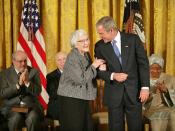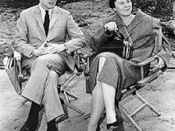In the opening chapters of "To Kill A Mockingbird," Harper Lee introduces several subtle instances of racism. However, when Jem and Scout are welcomed into Cal's Church in chapter 12, the reader really gets to travel behind the false disguise of Maycomb County's white society to see the harsh realities of the injustices suffered by the blacks. The black community is completely separate from the whites -- in fact, Cal lives in a totally different part of town! Another example of total racial segregation is the fact that Jem and Scout have never been to "that part of town," so they are unfamiliar with the Church's way of singing hymns ("lining"), and they don't understand "nigger talk." Even Lula, one of the black church members, says, "they got their church, we got our'n." Poverty is another injustice suffered by the blacks. Their First Purchase Church is very old and worn out.
The paint is cracked and peeling, it has no ceiling, there's a rough oak pulpit, and cheap cardboard fans must be used to keep the congregation cool. There is no piano, organ or church program in sight, and the whole church has to share one hymnbook! The graveyard contains only a few expensive headstones, with most graves merely outlined by broken glass. A further degradation occurs during the rest of the week, when the church building is used by whites for gambling.
A majority of the black community is illiterate because there are no schools for blacks in Maycomb County. Their only way of learning is from their parents or another elder. For example, Mrs. Buford taught Cal, and Cal taught her son, Zeebo. Consequently, only four blacks in the whole church can read.
In Tom Robinson case, he has virtually no chance of winning strictly due to his race. During his trial, Bob Ewell accuses Tom of raping his girl. Even though the Ewells are considered to be the "white trash" of Maycomb County, nearly all of white community supports them because they are white and Tom is black.
Despite all of these injustices, Chapter 12 also creates a feeling of support and sympathy for the black community. For example, even though they're oppressed, the black community still has a sense of pride. Their church is called First Purchase because it was paid for with the first earnings of freed slaves. This shows the black's great devotion to their religion. Also, despite all of its problems, First Purchase is actually the only church in Maycomb County with a bell and steeple.
A strong sense of pride in their community is demonstrated by the way that everyone sticks by each other. With Tom in jail, his wife barely has enough money to live, so the Church selflessly takes up a collection for the Robinson family. After the first collection, the preacher announces that nobody will be allowed to leave until ten dollars is collected, which everyone pitches in to contribute. Cal even hands the children her own money to donate - a telling symbol of her people's wealth of dignity amid their poverty in economic and civil rights.
Even though the white people don't treat the blacks equally, the blacks still show them respect. For example, as Jem, Scout and Cal are approaching the church, the men take off their hats and the women cross their arms at their waists. Also, even though Lula questions the presence of the white children, Zeebo insists that they are welcome regardless of race.
In conclusion, the author uses Chapter 12 to break down the polite facade of southern society to let the reader see the actual racism that goes on in Maycomb. However, she also shows us the respectfulness and dignity of the black community, which gives us hope for their future.





